My Health Record: Ethical Data Collection and Management in Health Care
VerifiedAdded on 2023/04/23
|18
|4469
|117
AI Summary
This report analyzes ethical data accumulation and management in healthcare, focusing on My Health Record. It assesses major ethical issues of utilizing secondary data, provides suggestions to clinicians for using health records, and provides considerations to researchers before using data from My Health Record.
Contribute Materials
Your contribution can guide someone’s learning journey. Share your
documents today.
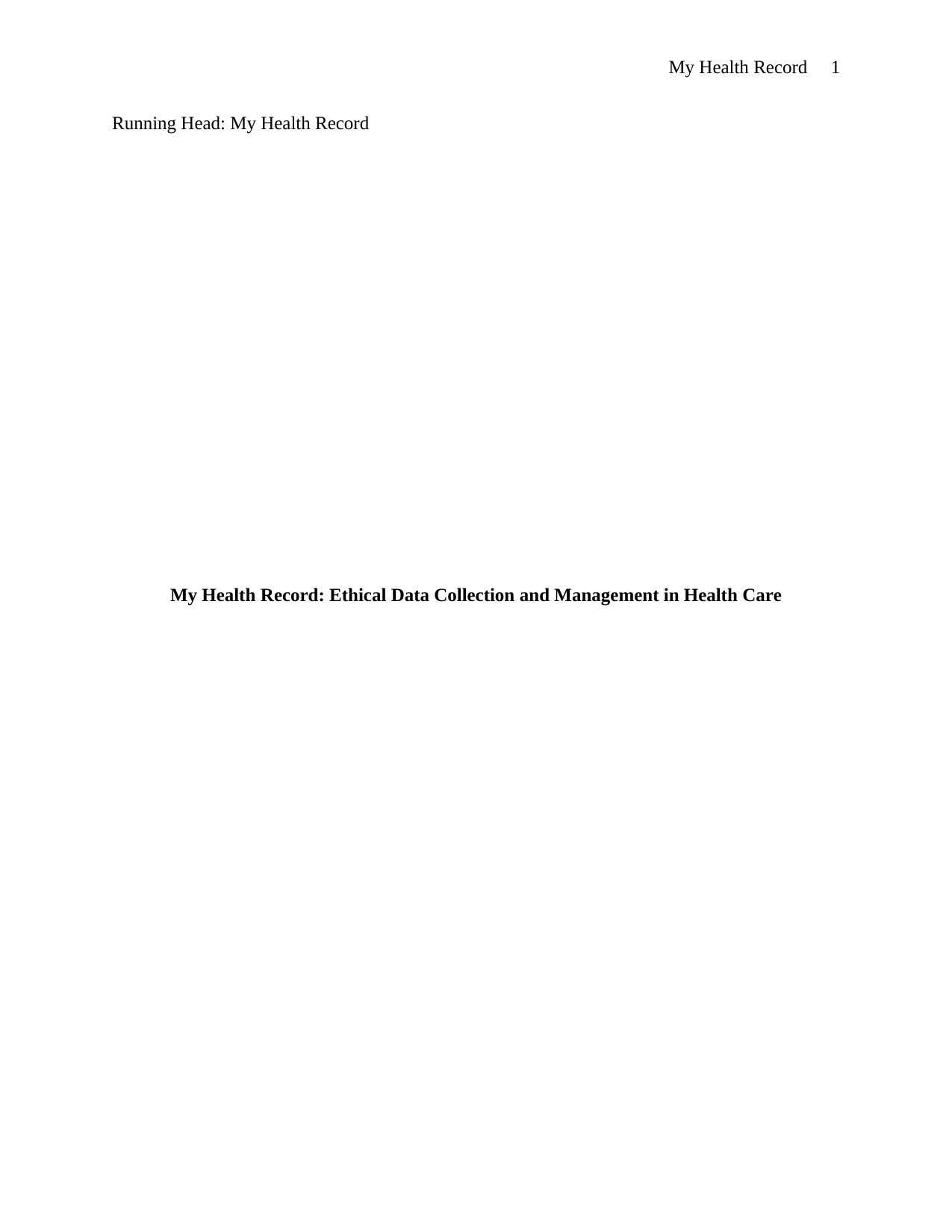
My Health Record 1
Running Head: My Health Record
My Health Record: Ethical Data Collection and Management in Health Care
Running Head: My Health Record
My Health Record: Ethical Data Collection and Management in Health Care
Secure Best Marks with AI Grader
Need help grading? Try our AI Grader for instant feedback on your assignments.
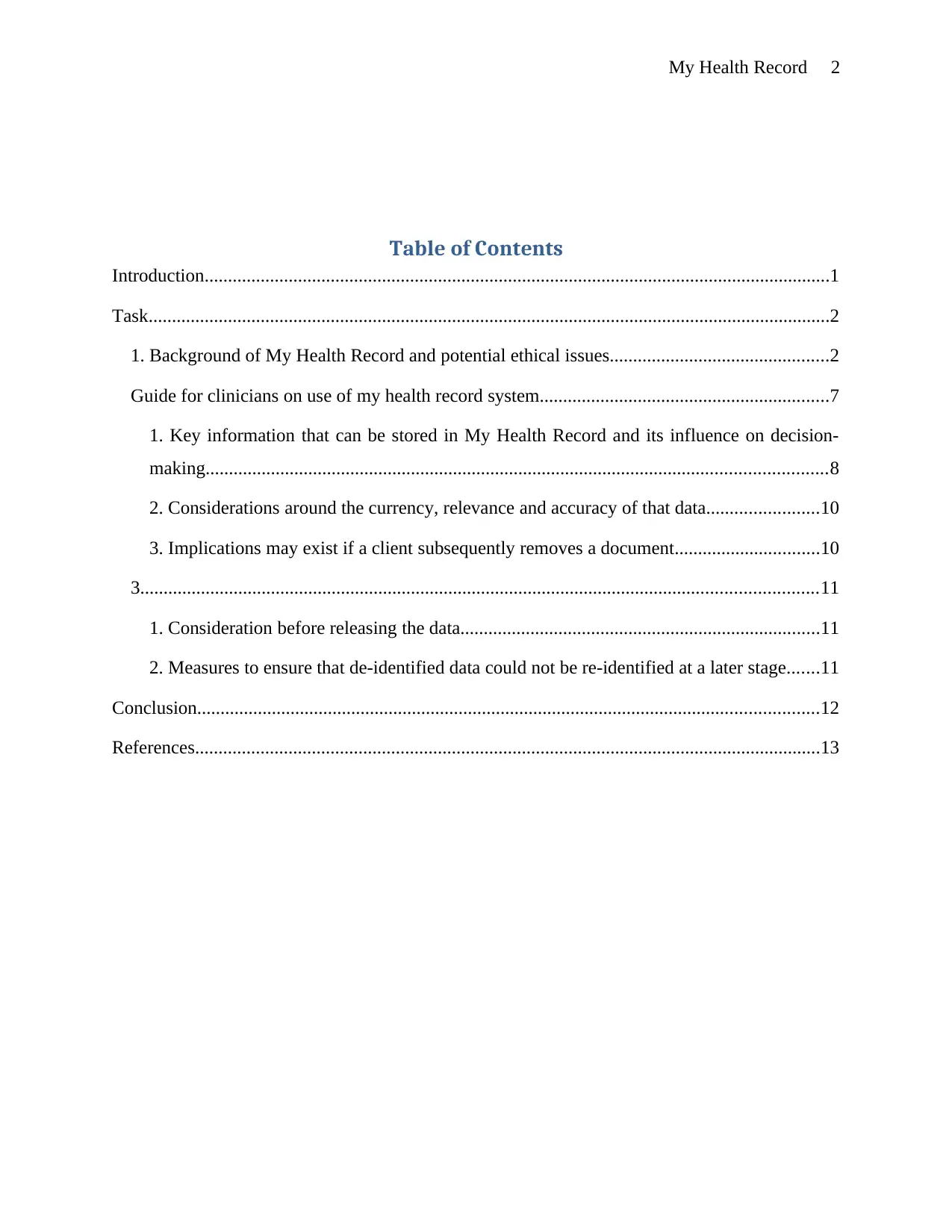
My Health Record 2
Table of Contents
Introduction......................................................................................................................................1
Task..................................................................................................................................................2
1. Background of My Health Record and potential ethical issues...............................................2
Guide for clinicians on use of my health record system..............................................................7
1. Key information that can be stored in My Health Record and its influence on decision-
making.....................................................................................................................................8
2. Considerations around the currency, relevance and accuracy of that data........................10
3. Implications may exist if a client subsequently removes a document...............................10
3.................................................................................................................................................11
1. Consideration before releasing the data.............................................................................11
2. Measures to ensure that de-identified data could not be re-identified at a later stage.......11
Conclusion.....................................................................................................................................12
References......................................................................................................................................13
Table of Contents
Introduction......................................................................................................................................1
Task..................................................................................................................................................2
1. Background of My Health Record and potential ethical issues...............................................2
Guide for clinicians on use of my health record system..............................................................7
1. Key information that can be stored in My Health Record and its influence on decision-
making.....................................................................................................................................8
2. Considerations around the currency, relevance and accuracy of that data........................10
3. Implications may exist if a client subsequently removes a document...............................10
3.................................................................................................................................................11
1. Consideration before releasing the data.............................................................................11
2. Measures to ensure that de-identified data could not be re-identified at a later stage.......11
Conclusion.....................................................................................................................................12
References......................................................................................................................................13
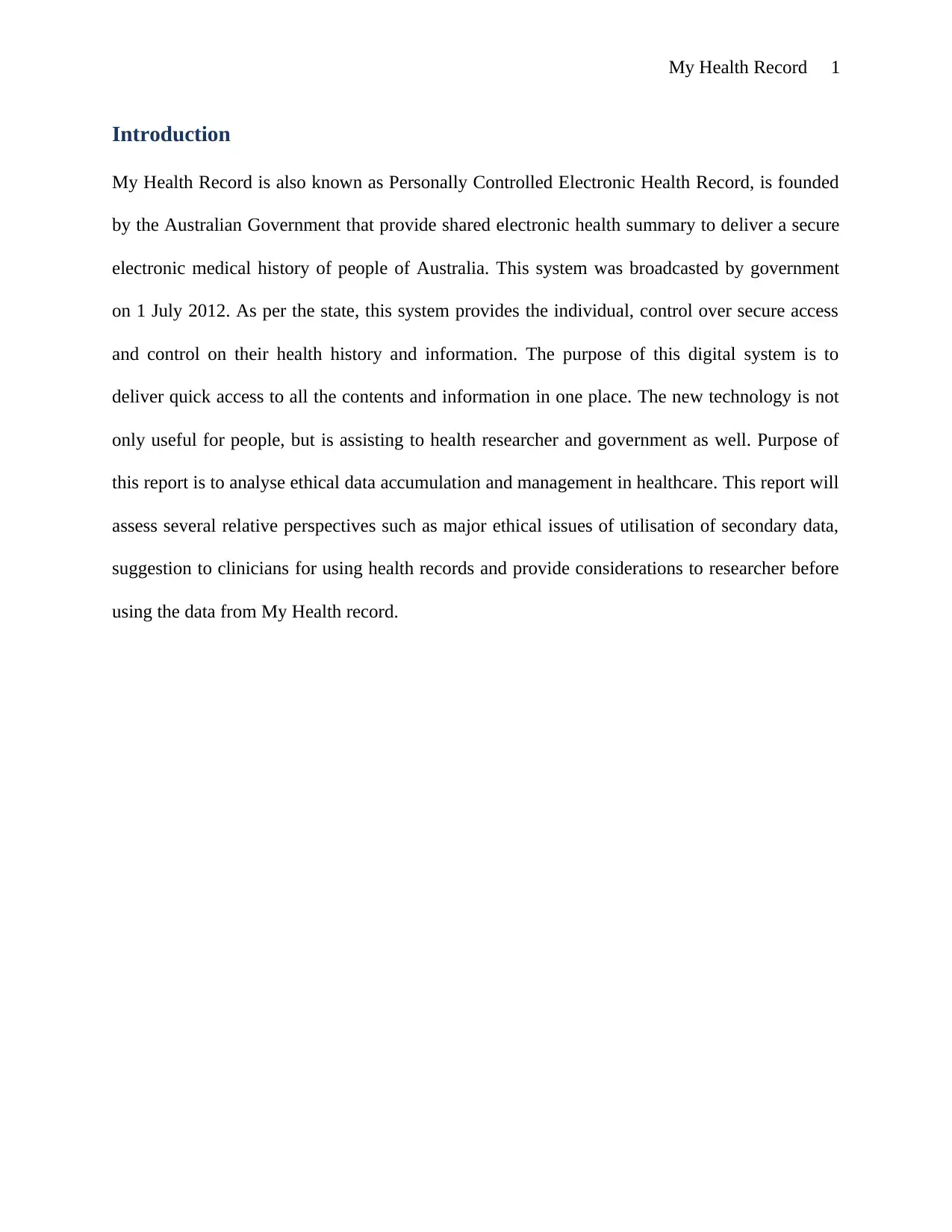
My Health Record 1
Introduction
My Health Record is also known as Personally Controlled Electronic Health Record, is founded
by the Australian Government that provide shared electronic health summary to deliver a secure
electronic medical history of people of Australia. This system was broadcasted by government
on 1 July 2012. As per the state, this system provides the individual, control over secure access
and control on their health history and information. The purpose of this digital system is to
deliver quick access to all the contents and information in one place. The new technology is not
only useful for people, but is assisting to health researcher and government as well. Purpose of
this report is to analyse ethical data accumulation and management in healthcare. This report will
assess several relative perspectives such as major ethical issues of utilisation of secondary data,
suggestion to clinicians for using health records and provide considerations to researcher before
using the data from My Health record.
Introduction
My Health Record is also known as Personally Controlled Electronic Health Record, is founded
by the Australian Government that provide shared electronic health summary to deliver a secure
electronic medical history of people of Australia. This system was broadcasted by government
on 1 July 2012. As per the state, this system provides the individual, control over secure access
and control on their health history and information. The purpose of this digital system is to
deliver quick access to all the contents and information in one place. The new technology is not
only useful for people, but is assisting to health researcher and government as well. Purpose of
this report is to analyse ethical data accumulation and management in healthcare. This report will
assess several relative perspectives such as major ethical issues of utilisation of secondary data,
suggestion to clinicians for using health records and provide considerations to researcher before
using the data from My Health record.
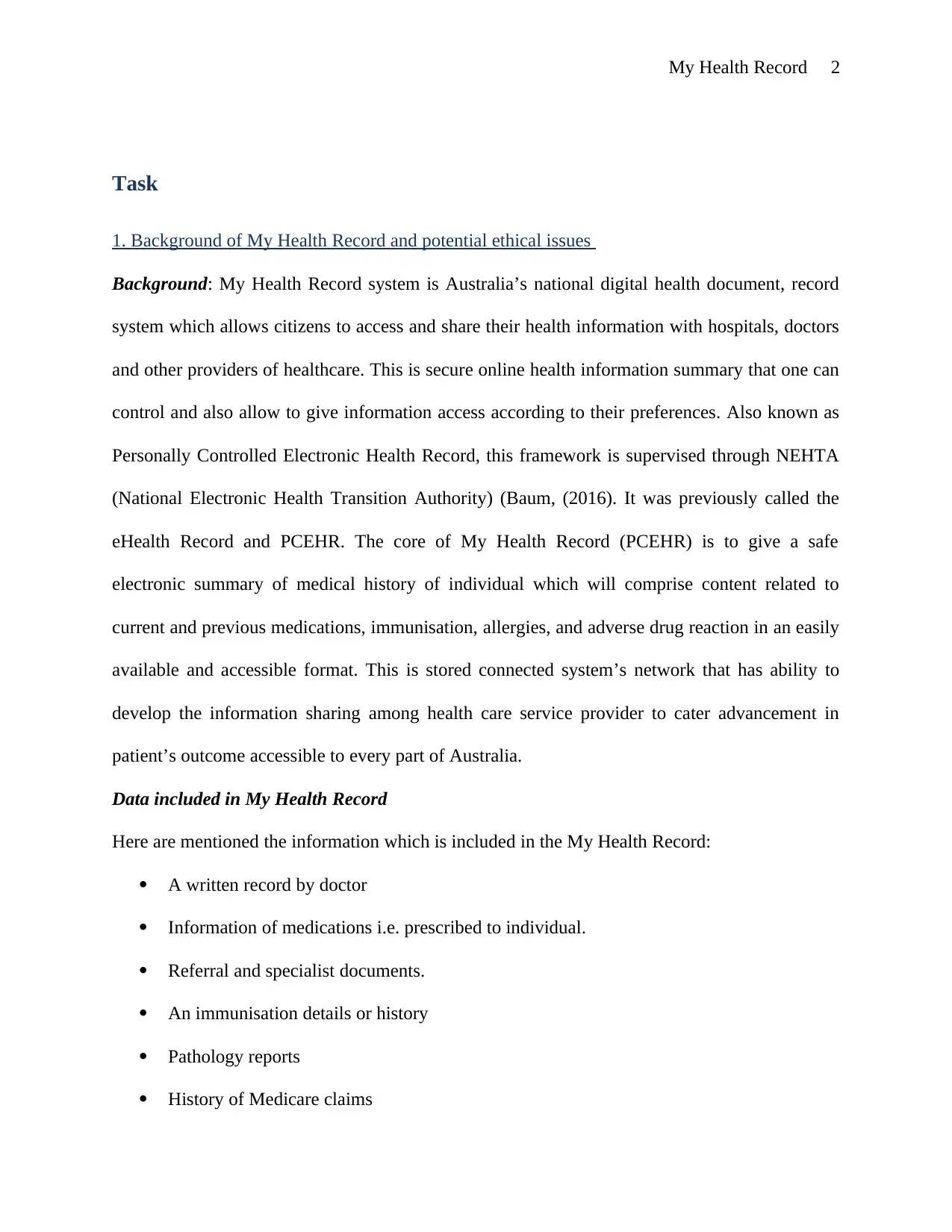
My Health Record 2
Task
1. Background of My Health Record and potential ethical issues
Background: My Health Record system is Australia’s national digital health document, record
system which allows citizens to access and share their health information with hospitals, doctors
and other providers of healthcare. This is secure online health information summary that one can
control and also allow to give information access according to their preferences. Also known as
Personally Controlled Electronic Health Record, this framework is supervised through NEHTA
(National Electronic Health Transition Authority) (Baum, (2016). It was previously called the
eHealth Record and PCEHR. The core of My Health Record (PCEHR) is to give a safe
electronic summary of medical history of individual which will comprise content related to
current and previous medications, immunisation, allergies, and adverse drug reaction in an easily
available and accessible format. This is stored connected system’s network that has ability to
develop the information sharing among health care service provider to cater advancement in
patient’s outcome accessible to every part of Australia.
Data included in My Health Record
Here are mentioned the information which is included in the My Health Record:
A written record by doctor
Information of medications i.e. prescribed to individual.
Referral and specialist documents.
An immunisation details or history
Pathology reports
History of Medicare claims
Task
1. Background of My Health Record and potential ethical issues
Background: My Health Record system is Australia’s national digital health document, record
system which allows citizens to access and share their health information with hospitals, doctors
and other providers of healthcare. This is secure online health information summary that one can
control and also allow to give information access according to their preferences. Also known as
Personally Controlled Electronic Health Record, this framework is supervised through NEHTA
(National Electronic Health Transition Authority) (Baum, (2016). It was previously called the
eHealth Record and PCEHR. The core of My Health Record (PCEHR) is to give a safe
electronic summary of medical history of individual which will comprise content related to
current and previous medications, immunisation, allergies, and adverse drug reaction in an easily
available and accessible format. This is stored connected system’s network that has ability to
develop the information sharing among health care service provider to cater advancement in
patient’s outcome accessible to every part of Australia.
Data included in My Health Record
Here are mentioned the information which is included in the My Health Record:
A written record by doctor
Information of medications i.e. prescribed to individual.
Referral and specialist documents.
An immunisation details or history
Pathology reports
History of Medicare claims
Secure Best Marks with AI Grader
Need help grading? Try our AI Grader for instant feedback on your assignments.
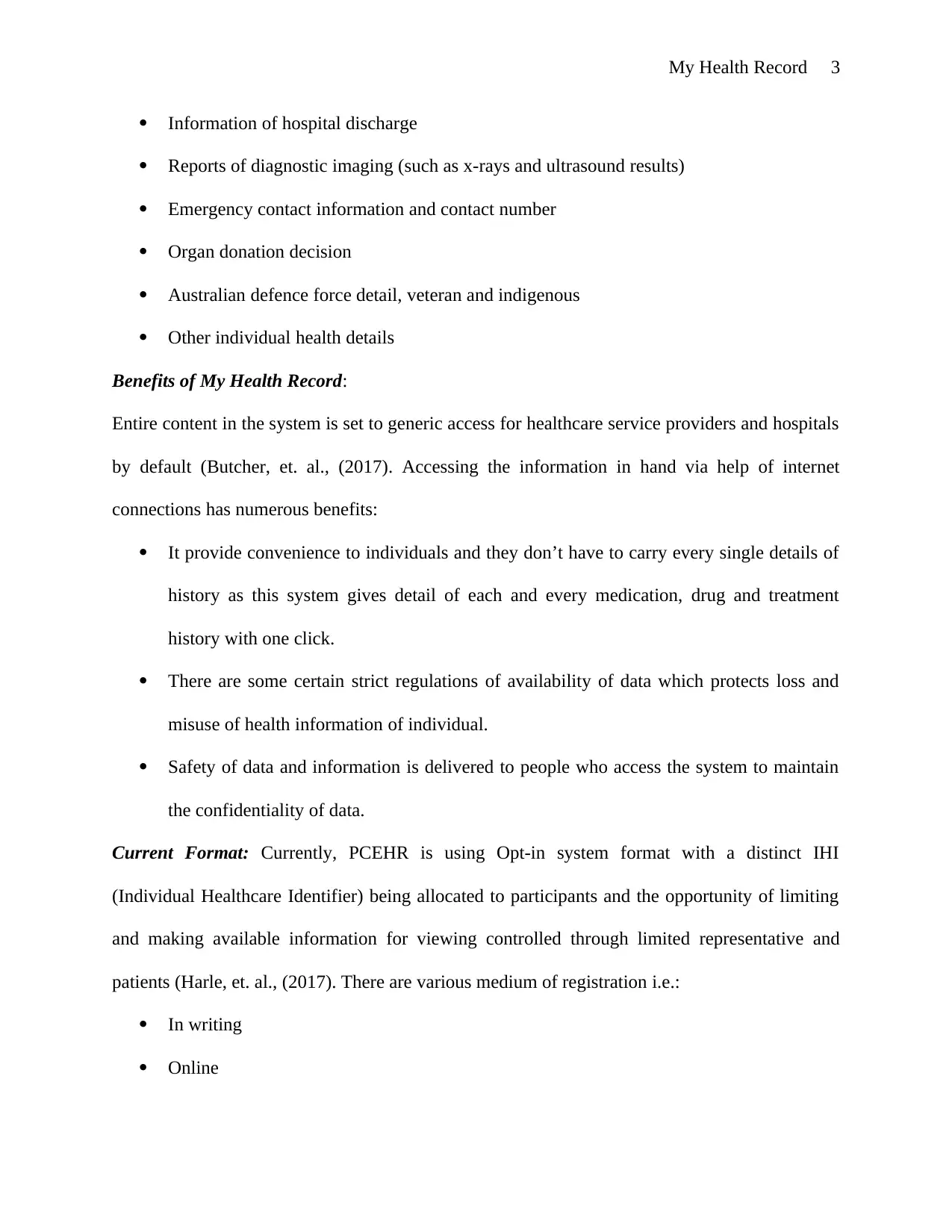
My Health Record 3
Information of hospital discharge
Reports of diagnostic imaging (such as x-rays and ultrasound results)
Emergency contact information and contact number
Organ donation decision
Australian defence force detail, veteran and indigenous
Other individual health details
Benefits of My Health Record:
Entire content in the system is set to generic access for healthcare service providers and hospitals
by default (Butcher, et. al., (2017). Accessing the information in hand via help of internet
connections has numerous benefits:
It provide convenience to individuals and they don’t have to carry every single details of
history as this system gives detail of each and every medication, drug and treatment
history with one click.
There are some certain strict regulations of availability of data which protects loss and
misuse of health information of individual.
Safety of data and information is delivered to people who access the system to maintain
the confidentiality of data.
Current Format: Currently, PCEHR is using Opt-in system format with a distinct IHI
(Individual Healthcare Identifier) being allocated to participants and the opportunity of limiting
and making available information for viewing controlled through limited representative and
patients (Harle, et. al., (2017). There are various medium of registration i.e.:
In writing
Online
Information of hospital discharge
Reports of diagnostic imaging (such as x-rays and ultrasound results)
Emergency contact information and contact number
Organ donation decision
Australian defence force detail, veteran and indigenous
Other individual health details
Benefits of My Health Record:
Entire content in the system is set to generic access for healthcare service providers and hospitals
by default (Butcher, et. al., (2017). Accessing the information in hand via help of internet
connections has numerous benefits:
It provide convenience to individuals and they don’t have to carry every single details of
history as this system gives detail of each and every medication, drug and treatment
history with one click.
There are some certain strict regulations of availability of data which protects loss and
misuse of health information of individual.
Safety of data and information is delivered to people who access the system to maintain
the confidentiality of data.
Current Format: Currently, PCEHR is using Opt-in system format with a distinct IHI
(Individual Healthcare Identifier) being allocated to participants and the opportunity of limiting
and making available information for viewing controlled through limited representative and
patients (Harle, et. al., (2017). There are various medium of registration i.e.:
In writing
Online
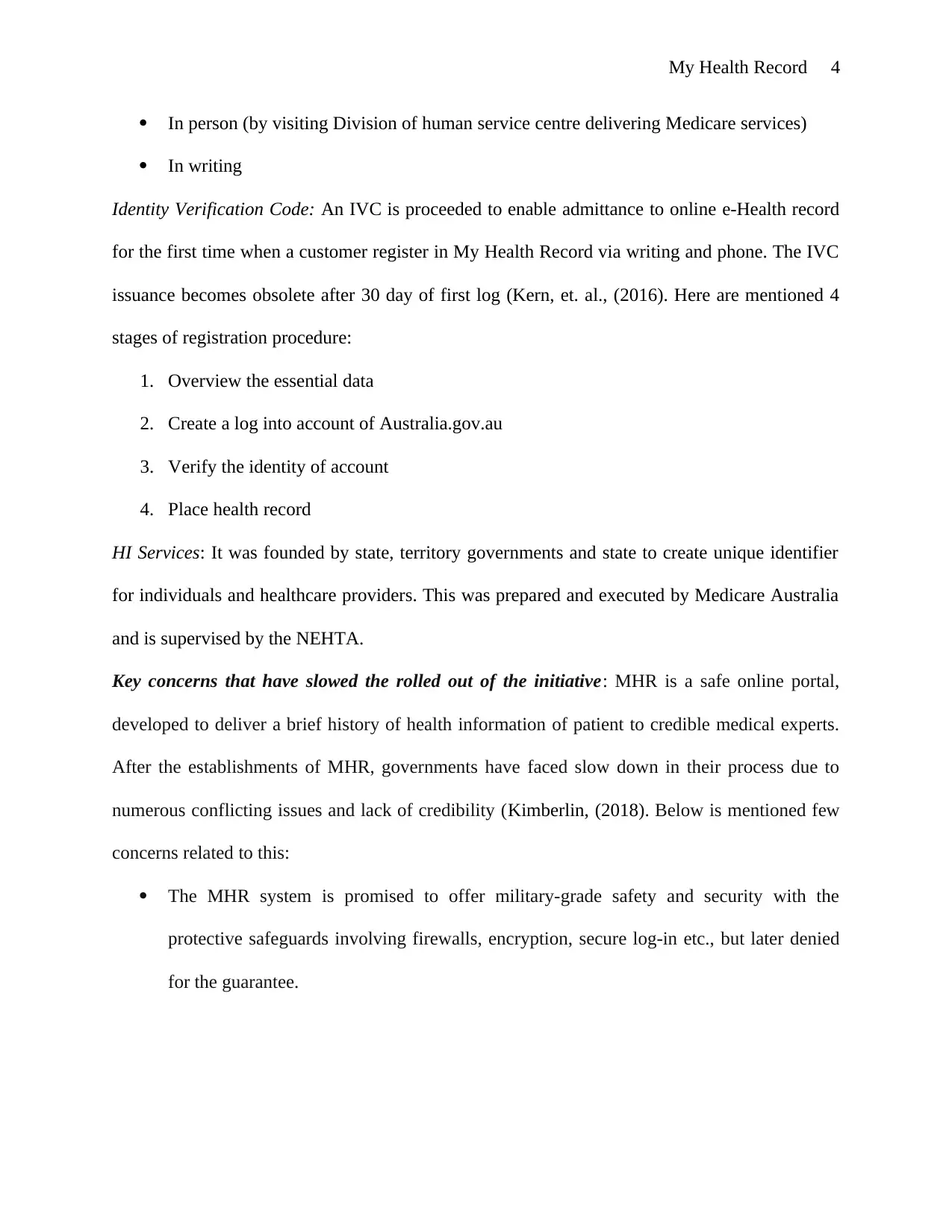
My Health Record 4
In person (by visiting Division of human service centre delivering Medicare services)
In writing
Identity Verification Code: An IVC is proceeded to enable admittance to online e-Health record
for the first time when a customer register in My Health Record via writing and phone. The IVC
issuance becomes obsolete after 30 day of first log (Kern, et. al., (2016). Here are mentioned 4
stages of registration procedure:
1. Overview the essential data
2. Create a log into account of Australia.gov.au
3. Verify the identity of account
4. Place health record
HI Services: It was founded by state, territory governments and state to create unique identifier
for individuals and healthcare providers. This was prepared and executed by Medicare Australia
and is supervised by the NEHTA.
Key concerns that have slowed the rolled out of the initiative: MHR is a safe online portal,
developed to deliver a brief history of health information of patient to credible medical experts.
After the establishments of MHR, governments have faced slow down in their process due to
numerous conflicting issues and lack of credibility (Kimberlin, (2018). Below is mentioned few
concerns related to this:
The MHR system is promised to offer military-grade safety and security with the
protective safeguards involving firewalls, encryption, secure log-in etc., but later denied
for the guarantee.
In person (by visiting Division of human service centre delivering Medicare services)
In writing
Identity Verification Code: An IVC is proceeded to enable admittance to online e-Health record
for the first time when a customer register in My Health Record via writing and phone. The IVC
issuance becomes obsolete after 30 day of first log (Kern, et. al., (2016). Here are mentioned 4
stages of registration procedure:
1. Overview the essential data
2. Create a log into account of Australia.gov.au
3. Verify the identity of account
4. Place health record
HI Services: It was founded by state, territory governments and state to create unique identifier
for individuals and healthcare providers. This was prepared and executed by Medicare Australia
and is supervised by the NEHTA.
Key concerns that have slowed the rolled out of the initiative: MHR is a safe online portal,
developed to deliver a brief history of health information of patient to credible medical experts.
After the establishments of MHR, governments have faced slow down in their process due to
numerous conflicting issues and lack of credibility (Kimberlin, (2018). Below is mentioned few
concerns related to this:
The MHR system is promised to offer military-grade safety and security with the
protective safeguards involving firewalls, encryption, secure log-in etc., but later denied
for the guarantee.
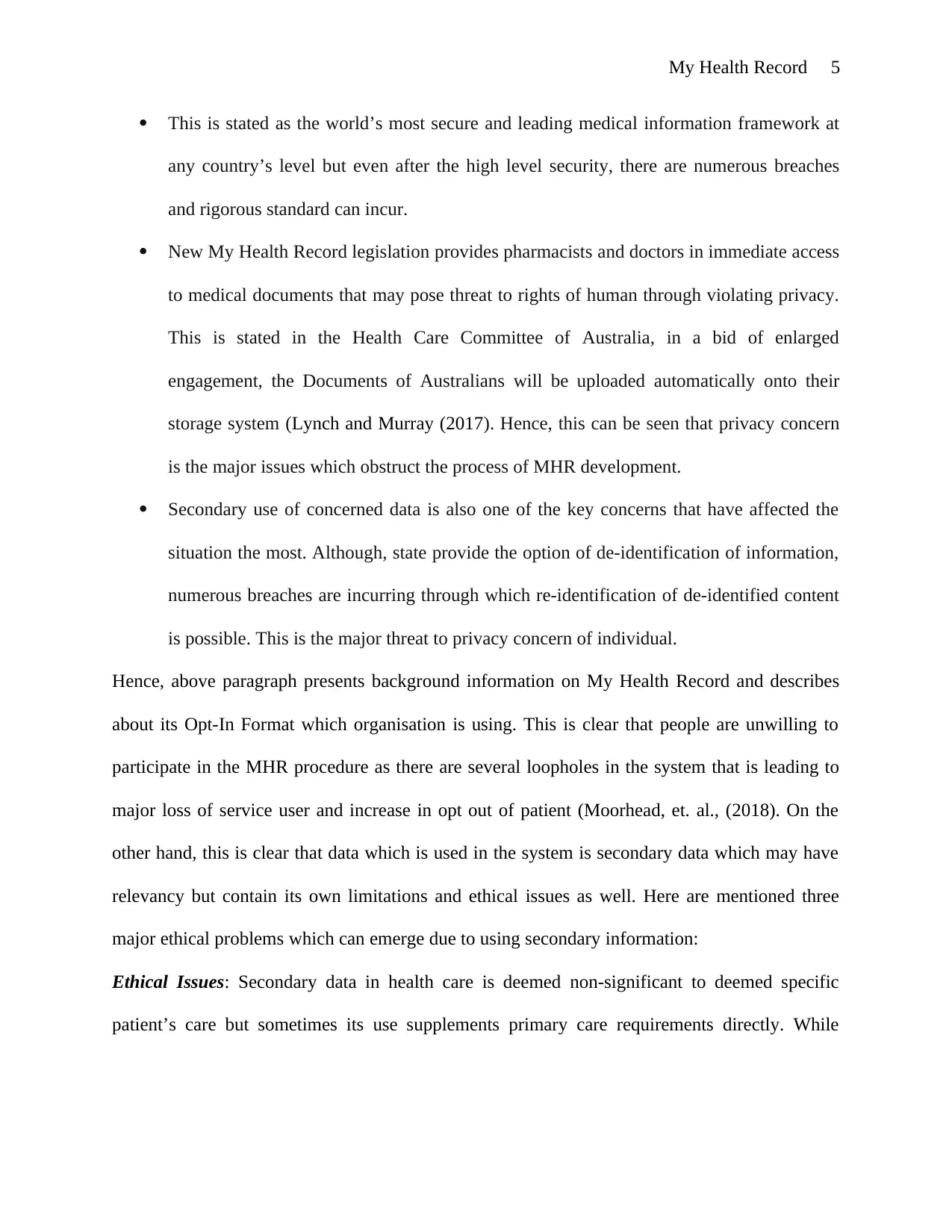
My Health Record 5
This is stated as the world’s most secure and leading medical information framework at
any country’s level but even after the high level security, there are numerous breaches
and rigorous standard can incur.
New My Health Record legislation provides pharmacists and doctors in immediate access
to medical documents that may pose threat to rights of human through violating privacy.
This is stated in the Health Care Committee of Australia, in a bid of enlarged
engagement, the Documents of Australians will be uploaded automatically onto their
storage system (Lynch and Murray (2017). Hence, this can be seen that privacy concern
is the major issues which obstruct the process of MHR development.
Secondary use of concerned data is also one of the key concerns that have affected the
situation the most. Although, state provide the option of de-identification of information,
numerous breaches are incurring through which re-identification of de-identified content
is possible. This is the major threat to privacy concern of individual.
Hence, above paragraph presents background information on My Health Record and describes
about its Opt-In Format which organisation is using. This is clear that people are unwilling to
participate in the MHR procedure as there are several loopholes in the system that is leading to
major loss of service user and increase in opt out of patient (Moorhead, et. al., (2018). On the
other hand, this is clear that data which is used in the system is secondary data which may have
relevancy but contain its own limitations and ethical issues as well. Here are mentioned three
major ethical problems which can emerge due to using secondary information:
Ethical Issues: Secondary data in health care is deemed non-significant to deemed specific
patient’s care but sometimes its use supplements primary care requirements directly. While
This is stated as the world’s most secure and leading medical information framework at
any country’s level but even after the high level security, there are numerous breaches
and rigorous standard can incur.
New My Health Record legislation provides pharmacists and doctors in immediate access
to medical documents that may pose threat to rights of human through violating privacy.
This is stated in the Health Care Committee of Australia, in a bid of enlarged
engagement, the Documents of Australians will be uploaded automatically onto their
storage system (Lynch and Murray (2017). Hence, this can be seen that privacy concern
is the major issues which obstruct the process of MHR development.
Secondary use of concerned data is also one of the key concerns that have affected the
situation the most. Although, state provide the option of de-identification of information,
numerous breaches are incurring through which re-identification of de-identified content
is possible. This is the major threat to privacy concern of individual.
Hence, above paragraph presents background information on My Health Record and describes
about its Opt-In Format which organisation is using. This is clear that people are unwilling to
participate in the MHR procedure as there are several loopholes in the system that is leading to
major loss of service user and increase in opt out of patient (Moorhead, et. al., (2018). On the
other hand, this is clear that data which is used in the system is secondary data which may have
relevancy but contain its own limitations and ethical issues as well. Here are mentioned three
major ethical problems which can emerge due to using secondary information:
Ethical Issues: Secondary data in health care is deemed non-significant to deemed specific
patient’s care but sometimes its use supplements primary care requirements directly. While
Paraphrase This Document
Need a fresh take? Get an instant paraphrase of this document with our AI Paraphraser
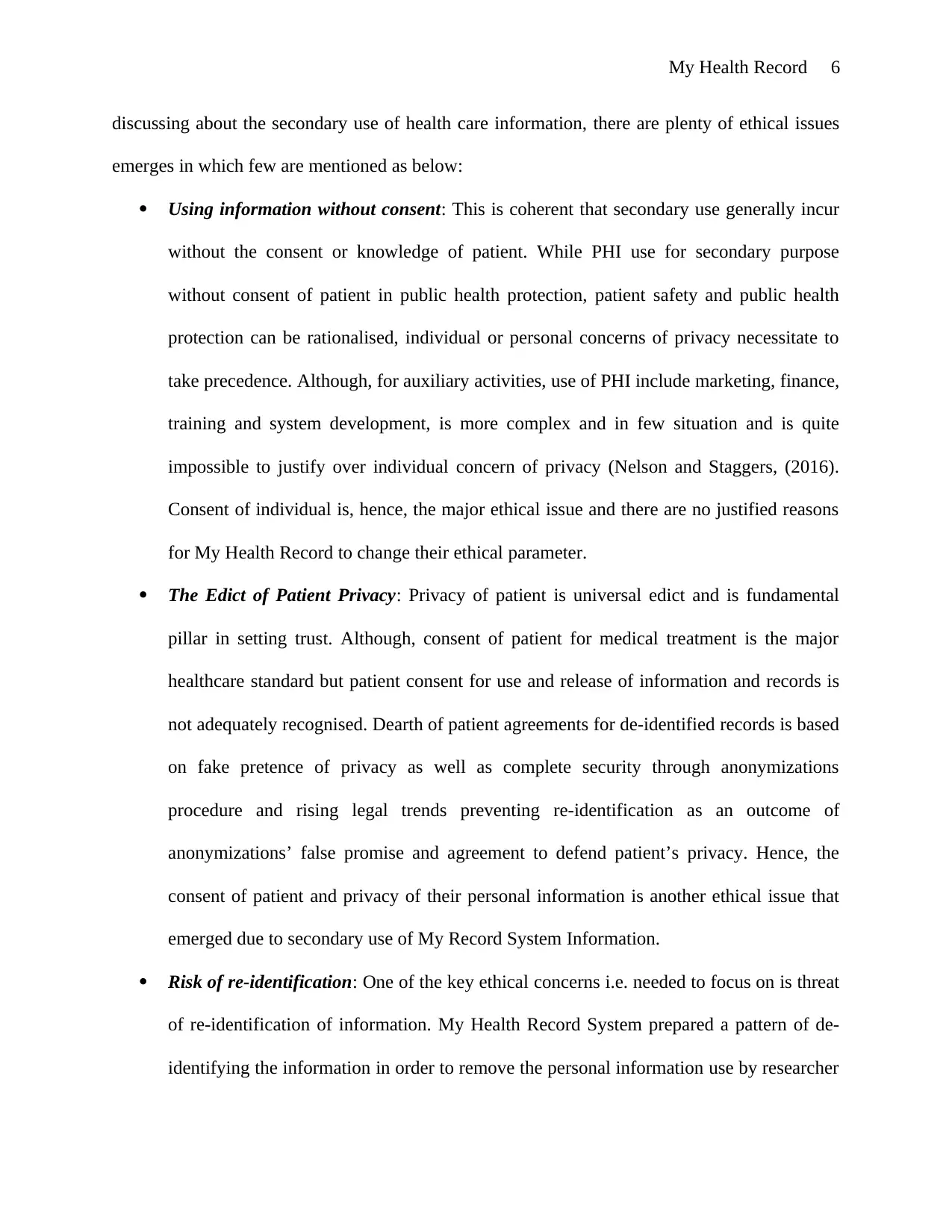
My Health Record 6
discussing about the secondary use of health care information, there are plenty of ethical issues
emerges in which few are mentioned as below:
Using information without consent: This is coherent that secondary use generally incur
without the consent or knowledge of patient. While PHI use for secondary purpose
without consent of patient in public health protection, patient safety and public health
protection can be rationalised, individual or personal concerns of privacy necessitate to
take precedence. Although, for auxiliary activities, use of PHI include marketing, finance,
training and system development, is more complex and in few situation and is quite
impossible to justify over individual concern of privacy (Nelson and Staggers, (2016).
Consent of individual is, hence, the major ethical issue and there are no justified reasons
for My Health Record to change their ethical parameter.
The Edict of Patient Privacy: Privacy of patient is universal edict and is fundamental
pillar in setting trust. Although, consent of patient for medical treatment is the major
healthcare standard but patient consent for use and release of information and records is
not adequately recognised. Dearth of patient agreements for de-identified records is based
on fake pretence of privacy as well as complete security through anonymizations
procedure and rising legal trends preventing re-identification as an outcome of
anonymizations’ false promise and agreement to defend patient’s privacy. Hence, the
consent of patient and privacy of their personal information is another ethical issue that
emerged due to secondary use of My Record System Information.
Risk of re-identification: One of the key ethical concerns i.e. needed to focus on is threat
of re-identification of information. My Health Record System prepared a pattern of de-
identifying the information in order to remove the personal information use by researcher
discussing about the secondary use of health care information, there are plenty of ethical issues
emerges in which few are mentioned as below:
Using information without consent: This is coherent that secondary use generally incur
without the consent or knowledge of patient. While PHI use for secondary purpose
without consent of patient in public health protection, patient safety and public health
protection can be rationalised, individual or personal concerns of privacy necessitate to
take precedence. Although, for auxiliary activities, use of PHI include marketing, finance,
training and system development, is more complex and in few situation and is quite
impossible to justify over individual concern of privacy (Nelson and Staggers, (2016).
Consent of individual is, hence, the major ethical issue and there are no justified reasons
for My Health Record to change their ethical parameter.
The Edict of Patient Privacy: Privacy of patient is universal edict and is fundamental
pillar in setting trust. Although, consent of patient for medical treatment is the major
healthcare standard but patient consent for use and release of information and records is
not adequately recognised. Dearth of patient agreements for de-identified records is based
on fake pretence of privacy as well as complete security through anonymizations
procedure and rising legal trends preventing re-identification as an outcome of
anonymizations’ false promise and agreement to defend patient’s privacy. Hence, the
consent of patient and privacy of their personal information is another ethical issue that
emerged due to secondary use of My Record System Information.
Risk of re-identification: One of the key ethical concerns i.e. needed to focus on is threat
of re-identification of information. My Health Record System prepared a pattern of de-
identifying the information in order to remove the personal information use by researcher
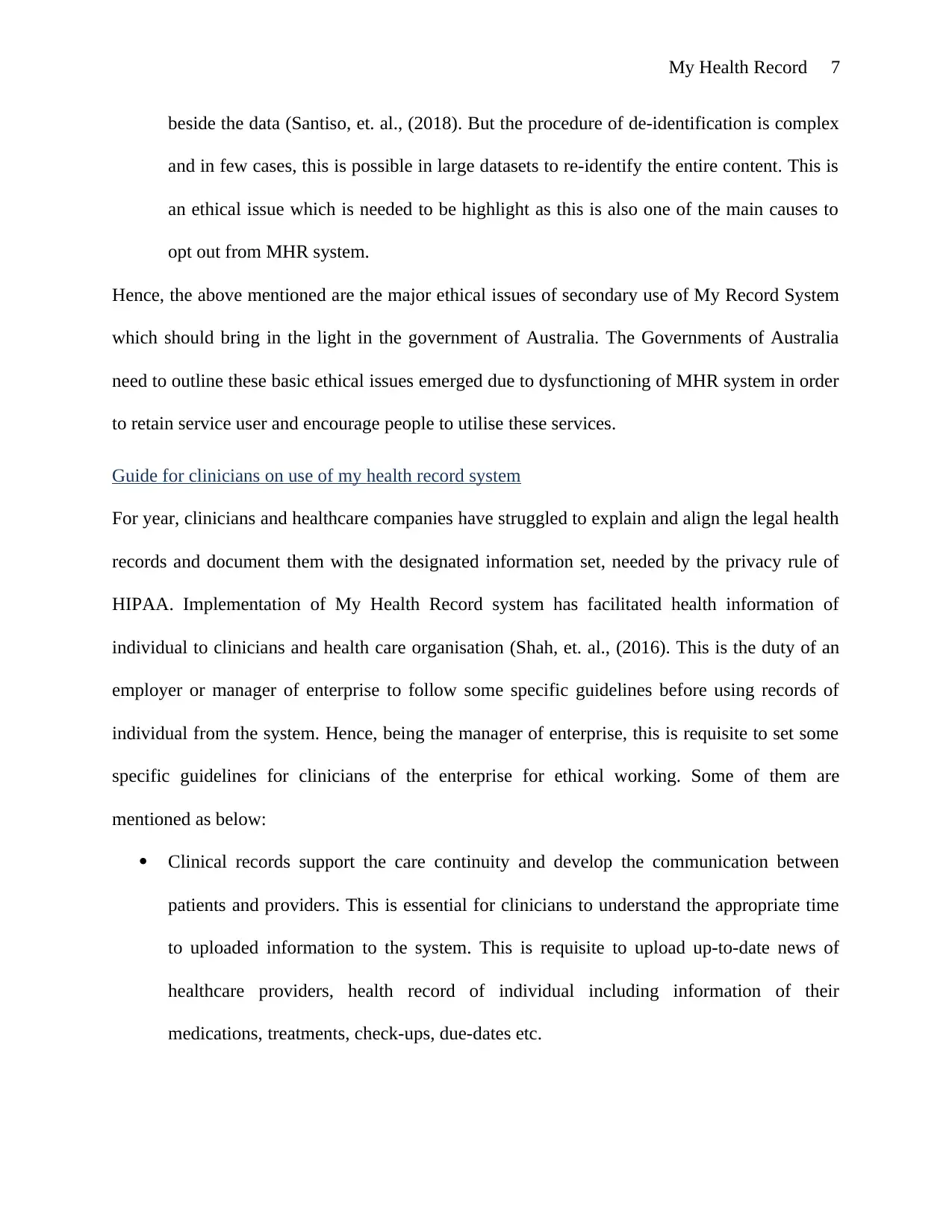
My Health Record 7
beside the data (Santiso, et. al., (2018). But the procedure of de-identification is complex
and in few cases, this is possible in large datasets to re-identify the entire content. This is
an ethical issue which is needed to be highlight as this is also one of the main causes to
opt out from MHR system.
Hence, the above mentioned are the major ethical issues of secondary use of My Record System
which should bring in the light in the government of Australia. The Governments of Australia
need to outline these basic ethical issues emerged due to dysfunctioning of MHR system in order
to retain service user and encourage people to utilise these services.
Guide for clinicians on use of my health record system
For year, clinicians and healthcare companies have struggled to explain and align the legal health
records and document them with the designated information set, needed by the privacy rule of
HIPAA. Implementation of My Health Record system has facilitated health information of
individual to clinicians and health care organisation (Shah, et. al., (2016). This is the duty of an
employer or manager of enterprise to follow some specific guidelines before using records of
individual from the system. Hence, being the manager of enterprise, this is requisite to set some
specific guidelines for clinicians of the enterprise for ethical working. Some of them are
mentioned as below:
Clinical records support the care continuity and develop the communication between
patients and providers. This is essential for clinicians to understand the appropriate time
to uploaded information to the system. This is requisite to upload up-to-date news of
healthcare providers, health record of individual including information of their
medications, treatments, check-ups, due-dates etc.
beside the data (Santiso, et. al., (2018). But the procedure of de-identification is complex
and in few cases, this is possible in large datasets to re-identify the entire content. This is
an ethical issue which is needed to be highlight as this is also one of the main causes to
opt out from MHR system.
Hence, the above mentioned are the major ethical issues of secondary use of My Record System
which should bring in the light in the government of Australia. The Governments of Australia
need to outline these basic ethical issues emerged due to dysfunctioning of MHR system in order
to retain service user and encourage people to utilise these services.
Guide for clinicians on use of my health record system
For year, clinicians and healthcare companies have struggled to explain and align the legal health
records and document them with the designated information set, needed by the privacy rule of
HIPAA. Implementation of My Health Record system has facilitated health information of
individual to clinicians and health care organisation (Shah, et. al., (2016). This is the duty of an
employer or manager of enterprise to follow some specific guidelines before using records of
individual from the system. Hence, being the manager of enterprise, this is requisite to set some
specific guidelines for clinicians of the enterprise for ethical working. Some of them are
mentioned as below:
Clinical records support the care continuity and develop the communication between
patients and providers. This is essential for clinicians to understand the appropriate time
to uploaded information to the system. This is requisite to upload up-to-date news of
healthcare providers, health record of individual including information of their
medications, treatments, check-ups, due-dates etc.
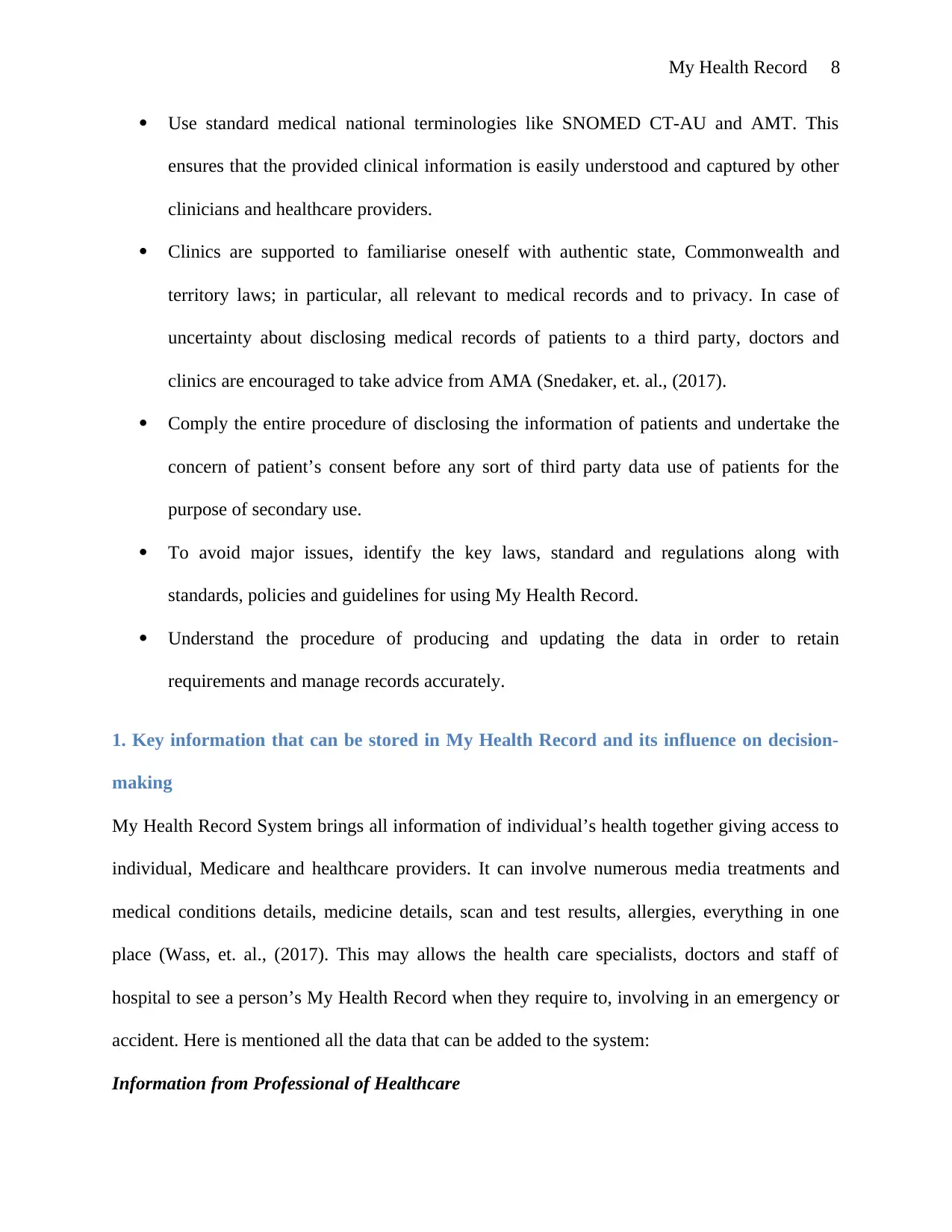
My Health Record 8
Use standard medical national terminologies like SNOMED CT-AU and AMT. This
ensures that the provided clinical information is easily understood and captured by other
clinicians and healthcare providers.
Clinics are supported to familiarise oneself with authentic state, Commonwealth and
territory laws; in particular, all relevant to medical records and to privacy. In case of
uncertainty about disclosing medical records of patients to a third party, doctors and
clinics are encouraged to take advice from AMA (Snedaker, et. al., (2017).
Comply the entire procedure of disclosing the information of patients and undertake the
concern of patient’s consent before any sort of third party data use of patients for the
purpose of secondary use.
To avoid major issues, identify the key laws, standard and regulations along with
standards, policies and guidelines for using My Health Record.
Understand the procedure of producing and updating the data in order to retain
requirements and manage records accurately.
1. Key information that can be stored in My Health Record and its influence on decision-
making
My Health Record System brings all information of individual’s health together giving access to
individual, Medicare and healthcare providers. It can involve numerous media treatments and
medical conditions details, medicine details, scan and test results, allergies, everything in one
place (Wass, et. al., (2017). This may allows the health care specialists, doctors and staff of
hospital to see a person’s My Health Record when they require to, involving in an emergency or
accident. Here is mentioned all the data that can be added to the system:
Information from Professional of Healthcare
Use standard medical national terminologies like SNOMED CT-AU and AMT. This
ensures that the provided clinical information is easily understood and captured by other
clinicians and healthcare providers.
Clinics are supported to familiarise oneself with authentic state, Commonwealth and
territory laws; in particular, all relevant to medical records and to privacy. In case of
uncertainty about disclosing medical records of patients to a third party, doctors and
clinics are encouraged to take advice from AMA (Snedaker, et. al., (2017).
Comply the entire procedure of disclosing the information of patients and undertake the
concern of patient’s consent before any sort of third party data use of patients for the
purpose of secondary use.
To avoid major issues, identify the key laws, standard and regulations along with
standards, policies and guidelines for using My Health Record.
Understand the procedure of producing and updating the data in order to retain
requirements and manage records accurately.
1. Key information that can be stored in My Health Record and its influence on decision-
making
My Health Record System brings all information of individual’s health together giving access to
individual, Medicare and healthcare providers. It can involve numerous media treatments and
medical conditions details, medicine details, scan and test results, allergies, everything in one
place (Wass, et. al., (2017). This may allows the health care specialists, doctors and staff of
hospital to see a person’s My Health Record when they require to, involving in an emergency or
accident. Here is mentioned all the data that can be added to the system:
Information from Professional of Healthcare
Secure Best Marks with AI Grader
Need help grading? Try our AI Grader for instant feedback on your assignments.
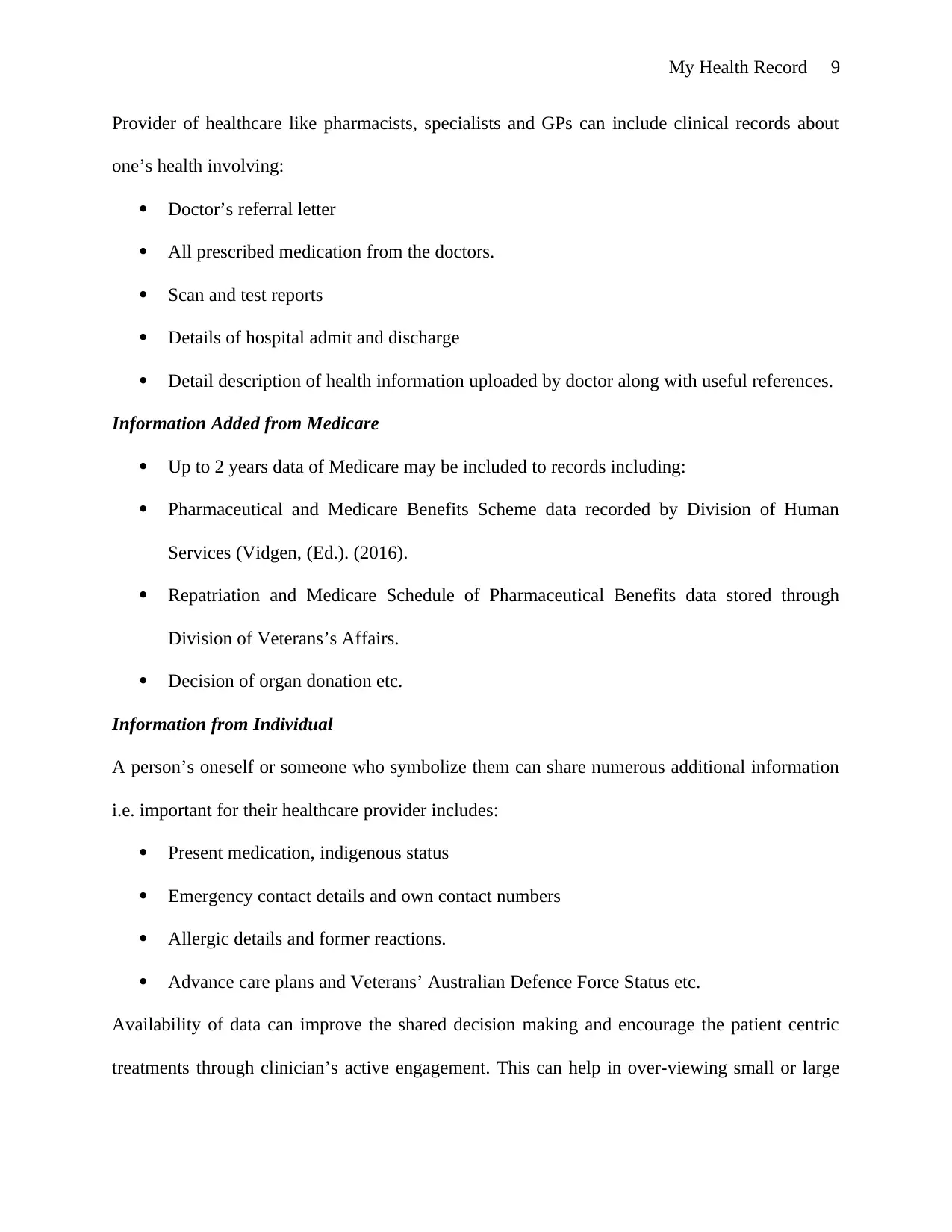
My Health Record 9
Provider of healthcare like pharmacists, specialists and GPs can include clinical records about
one’s health involving:
Doctor’s referral letter
All prescribed medication from the doctors.
Scan and test reports
Details of hospital admit and discharge
Detail description of health information uploaded by doctor along with useful references.
Information Added from Medicare
Up to 2 years data of Medicare may be included to records including:
Pharmaceutical and Medicare Benefits Scheme data recorded by Division of Human
Services (Vidgen, (Ed.). (2016).
Repatriation and Medicare Schedule of Pharmaceutical Benefits data stored through
Division of Veterans’s Affairs.
Decision of organ donation etc.
Information from Individual
A person’s oneself or someone who symbolize them can share numerous additional information
i.e. important for their healthcare provider includes:
Present medication, indigenous status
Emergency contact details and own contact numbers
Allergic details and former reactions.
Advance care plans and Veterans’ Australian Defence Force Status etc.
Availability of data can improve the shared decision making and encourage the patient centric
treatments through clinician’s active engagement. This can help in over-viewing small or large
Provider of healthcare like pharmacists, specialists and GPs can include clinical records about
one’s health involving:
Doctor’s referral letter
All prescribed medication from the doctors.
Scan and test reports
Details of hospital admit and discharge
Detail description of health information uploaded by doctor along with useful references.
Information Added from Medicare
Up to 2 years data of Medicare may be included to records including:
Pharmaceutical and Medicare Benefits Scheme data recorded by Division of Human
Services (Vidgen, (Ed.). (2016).
Repatriation and Medicare Schedule of Pharmaceutical Benefits data stored through
Division of Veterans’s Affairs.
Decision of organ donation etc.
Information from Individual
A person’s oneself or someone who symbolize them can share numerous additional information
i.e. important for their healthcare provider includes:
Present medication, indigenous status
Emergency contact details and own contact numbers
Allergic details and former reactions.
Advance care plans and Veterans’ Australian Defence Force Status etc.
Availability of data can improve the shared decision making and encourage the patient centric
treatments through clinician’s active engagement. This can help in over-viewing small or large
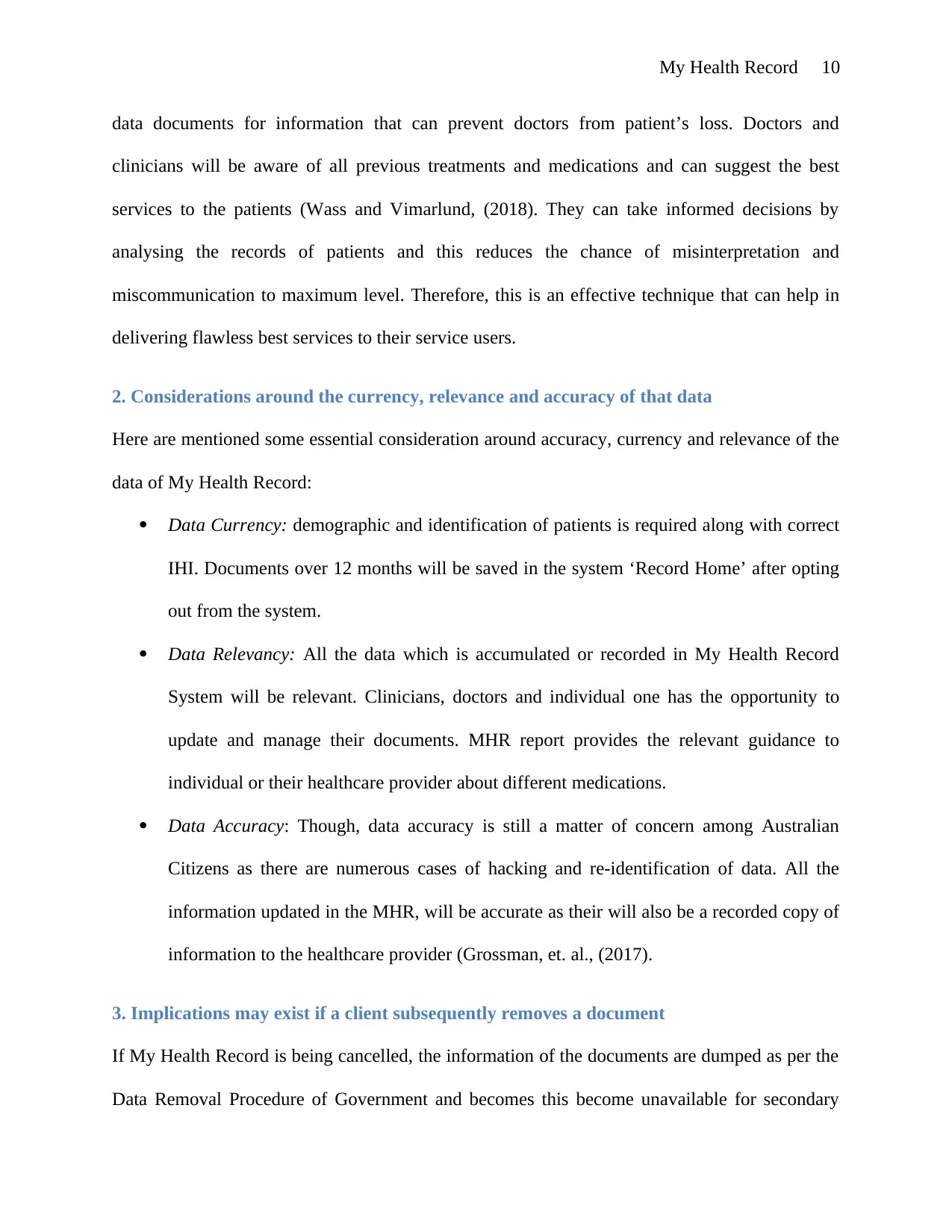
My Health Record 10
data documents for information that can prevent doctors from patient’s loss. Doctors and
clinicians will be aware of all previous treatments and medications and can suggest the best
services to the patients (Wass and Vimarlund, (2018). They can take informed decisions by
analysing the records of patients and this reduces the chance of misinterpretation and
miscommunication to maximum level. Therefore, this is an effective technique that can help in
delivering flawless best services to their service users.
2. Considerations around the currency, relevance and accuracy of that data
Here are mentioned some essential consideration around accuracy, currency and relevance of the
data of My Health Record:
Data Currency: demographic and identification of patients is required along with correct
IHI. Documents over 12 months will be saved in the system ‘Record Home’ after opting
out from the system.
Data Relevancy: All the data which is accumulated or recorded in My Health Record
System will be relevant. Clinicians, doctors and individual one has the opportunity to
update and manage their documents. MHR report provides the relevant guidance to
individual or their healthcare provider about different medications.
Data Accuracy: Though, data accuracy is still a matter of concern among Australian
Citizens as there are numerous cases of hacking and re-identification of data. All the
information updated in the MHR, will be accurate as their will also be a recorded copy of
information to the healthcare provider (Grossman, et. al., (2017).
3. Implications may exist if a client subsequently removes a document
If My Health Record is being cancelled, the information of the documents are dumped as per the
Data Removal Procedure of Government and becomes this become unavailable for secondary
data documents for information that can prevent doctors from patient’s loss. Doctors and
clinicians will be aware of all previous treatments and medications and can suggest the best
services to the patients (Wass and Vimarlund, (2018). They can take informed decisions by
analysing the records of patients and this reduces the chance of misinterpretation and
miscommunication to maximum level. Therefore, this is an effective technique that can help in
delivering flawless best services to their service users.
2. Considerations around the currency, relevance and accuracy of that data
Here are mentioned some essential consideration around accuracy, currency and relevance of the
data of My Health Record:
Data Currency: demographic and identification of patients is required along with correct
IHI. Documents over 12 months will be saved in the system ‘Record Home’ after opting
out from the system.
Data Relevancy: All the data which is accumulated or recorded in My Health Record
System will be relevant. Clinicians, doctors and individual one has the opportunity to
update and manage their documents. MHR report provides the relevant guidance to
individual or their healthcare provider about different medications.
Data Accuracy: Though, data accuracy is still a matter of concern among Australian
Citizens as there are numerous cases of hacking and re-identification of data. All the
information updated in the MHR, will be accurate as their will also be a recorded copy of
information to the healthcare provider (Grossman, et. al., (2017).
3. Implications may exist if a client subsequently removes a document
If My Health Record is being cancelled, the information of the documents are dumped as per the
Data Removal Procedure of Government and becomes this become unavailable for secondary
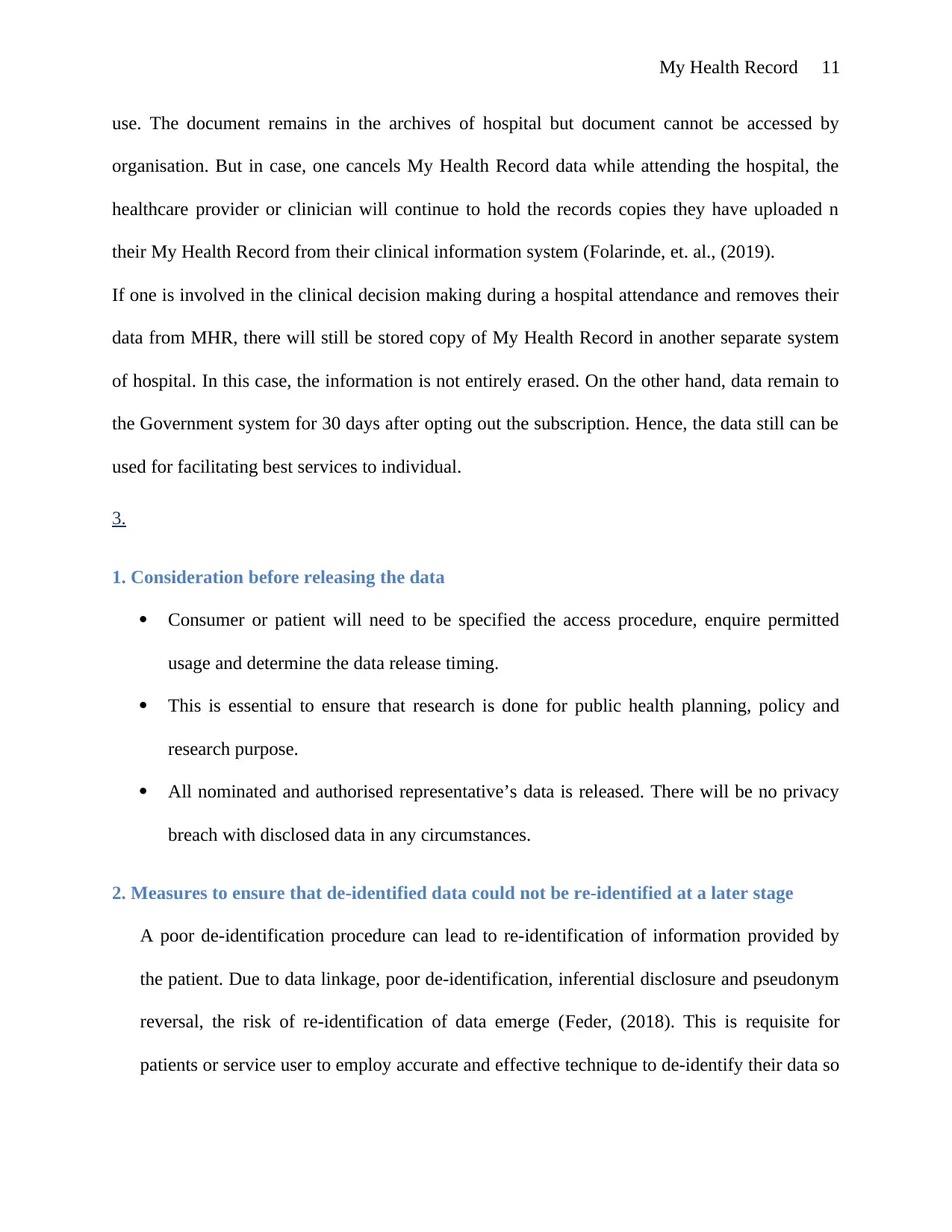
My Health Record 11
use. The document remains in the archives of hospital but document cannot be accessed by
organisation. But in case, one cancels My Health Record data while attending the hospital, the
healthcare provider or clinician will continue to hold the records copies they have uploaded n
their My Health Record from their clinical information system (Folarinde, et. al., (2019).
If one is involved in the clinical decision making during a hospital attendance and removes their
data from MHR, there will still be stored copy of My Health Record in another separate system
of hospital. In this case, the information is not entirely erased. On the other hand, data remain to
the Government system for 30 days after opting out the subscription. Hence, the data still can be
used for facilitating best services to individual.
3.
1. Consideration before releasing the data
Consumer or patient will need to be specified the access procedure, enquire permitted
usage and determine the data release timing.
This is essential to ensure that research is done for public health planning, policy and
research purpose.
All nominated and authorised representative’s data is released. There will be no privacy
breach with disclosed data in any circumstances.
2. Measures to ensure that de-identified data could not be re-identified at a later stage
A poor de-identification procedure can lead to re-identification of information provided by
the patient. Due to data linkage, poor de-identification, inferential disclosure and pseudonym
reversal, the risk of re-identification of data emerge (Feder, (2018). This is requisite for
patients or service user to employ accurate and effective technique to de-identify their data so
use. The document remains in the archives of hospital but document cannot be accessed by
organisation. But in case, one cancels My Health Record data while attending the hospital, the
healthcare provider or clinician will continue to hold the records copies they have uploaded n
their My Health Record from their clinical information system (Folarinde, et. al., (2019).
If one is involved in the clinical decision making during a hospital attendance and removes their
data from MHR, there will still be stored copy of My Health Record in another separate system
of hospital. In this case, the information is not entirely erased. On the other hand, data remain to
the Government system for 30 days after opting out the subscription. Hence, the data still can be
used for facilitating best services to individual.
3.
1. Consideration before releasing the data
Consumer or patient will need to be specified the access procedure, enquire permitted
usage and determine the data release timing.
This is essential to ensure that research is done for public health planning, policy and
research purpose.
All nominated and authorised representative’s data is released. There will be no privacy
breach with disclosed data in any circumstances.
2. Measures to ensure that de-identified data could not be re-identified at a later stage
A poor de-identification procedure can lead to re-identification of information provided by
the patient. Due to data linkage, poor de-identification, inferential disclosure and pseudonym
reversal, the risk of re-identification of data emerge (Feder, (2018). This is requisite for
patients or service user to employ accurate and effective technique to de-identify their data so
Paraphrase This Document
Need a fresh take? Get an instant paraphrase of this document with our AI Paraphraser
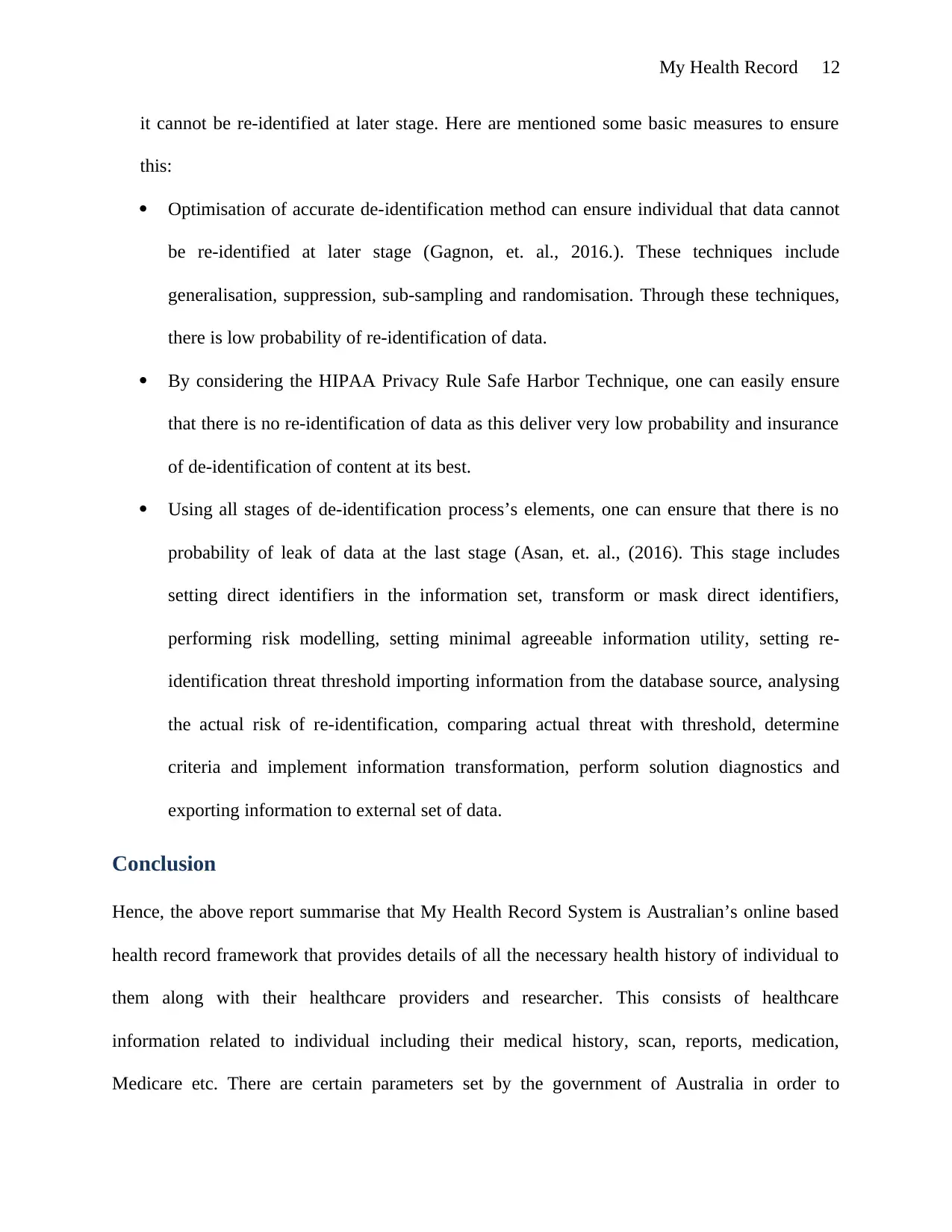
My Health Record 12
it cannot be re-identified at later stage. Here are mentioned some basic measures to ensure
this:
Optimisation of accurate de-identification method can ensure individual that data cannot
be re-identified at later stage (Gagnon, et. al., 2016.). These techniques include
generalisation, suppression, sub-sampling and randomisation. Through these techniques,
there is low probability of re-identification of data.
By considering the HIPAA Privacy Rule Safe Harbor Technique, one can easily ensure
that there is no re-identification of data as this deliver very low probability and insurance
of de-identification of content at its best.
Using all stages of de-identification process’s elements, one can ensure that there is no
probability of leak of data at the last stage (Asan, et. al., (2016). This stage includes
setting direct identifiers in the information set, transform or mask direct identifiers,
performing risk modelling, setting minimal agreeable information utility, setting re-
identification threat threshold importing information from the database source, analysing
the actual risk of re-identification, comparing actual threat with threshold, determine
criteria and implement information transformation, perform solution diagnostics and
exporting information to external set of data.
Conclusion
Hence, the above report summarise that My Health Record System is Australian’s online based
health record framework that provides details of all the necessary health history of individual to
them along with their healthcare providers and researcher. This consists of healthcare
information related to individual including their medical history, scan, reports, medication,
Medicare etc. There are certain parameters set by the government of Australia in order to
it cannot be re-identified at later stage. Here are mentioned some basic measures to ensure
this:
Optimisation of accurate de-identification method can ensure individual that data cannot
be re-identified at later stage (Gagnon, et. al., 2016.). These techniques include
generalisation, suppression, sub-sampling and randomisation. Through these techniques,
there is low probability of re-identification of data.
By considering the HIPAA Privacy Rule Safe Harbor Technique, one can easily ensure
that there is no re-identification of data as this deliver very low probability and insurance
of de-identification of content at its best.
Using all stages of de-identification process’s elements, one can ensure that there is no
probability of leak of data at the last stage (Asan, et. al., (2016). This stage includes
setting direct identifiers in the information set, transform or mask direct identifiers,
performing risk modelling, setting minimal agreeable information utility, setting re-
identification threat threshold importing information from the database source, analysing
the actual risk of re-identification, comparing actual threat with threshold, determine
criteria and implement information transformation, perform solution diagnostics and
exporting information to external set of data.
Conclusion
Hence, the above report summarise that My Health Record System is Australian’s online based
health record framework that provides details of all the necessary health history of individual to
them along with their healthcare providers and researcher. This consists of healthcare
information related to individual including their medical history, scan, reports, medication,
Medicare etc. There are certain parameters set by the government of Australia in order to
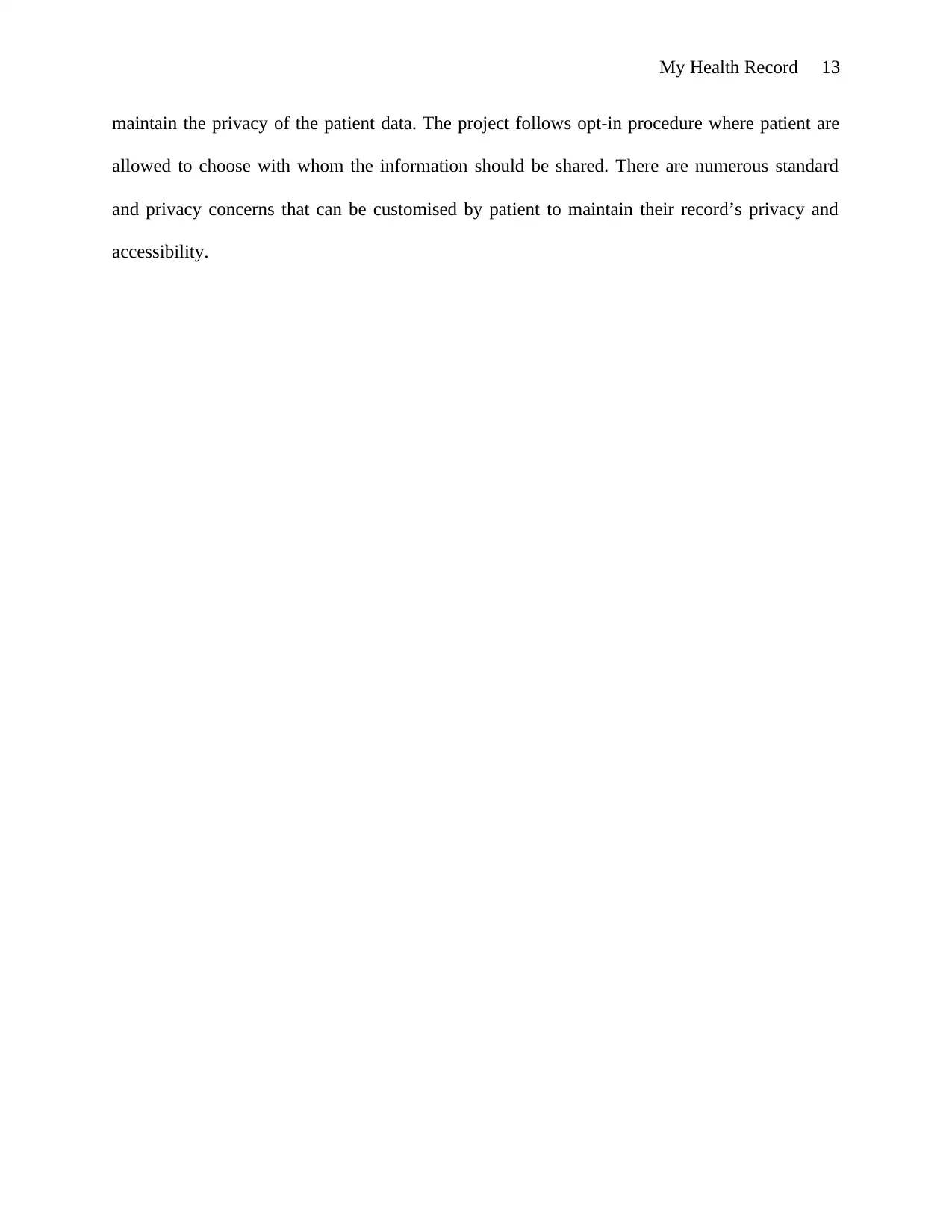
My Health Record 13
maintain the privacy of the patient data. The project follows opt-in procedure where patient are
allowed to choose with whom the information should be shared. There are numerous standard
and privacy concerns that can be customised by patient to maintain their record’s privacy and
accessibility.
maintain the privacy of the patient data. The project follows opt-in procedure where patient are
allowed to choose with whom the information should be shared. There are numerous standard
and privacy concerns that can be customised by patient to maintain their record’s privacy and
accessibility.
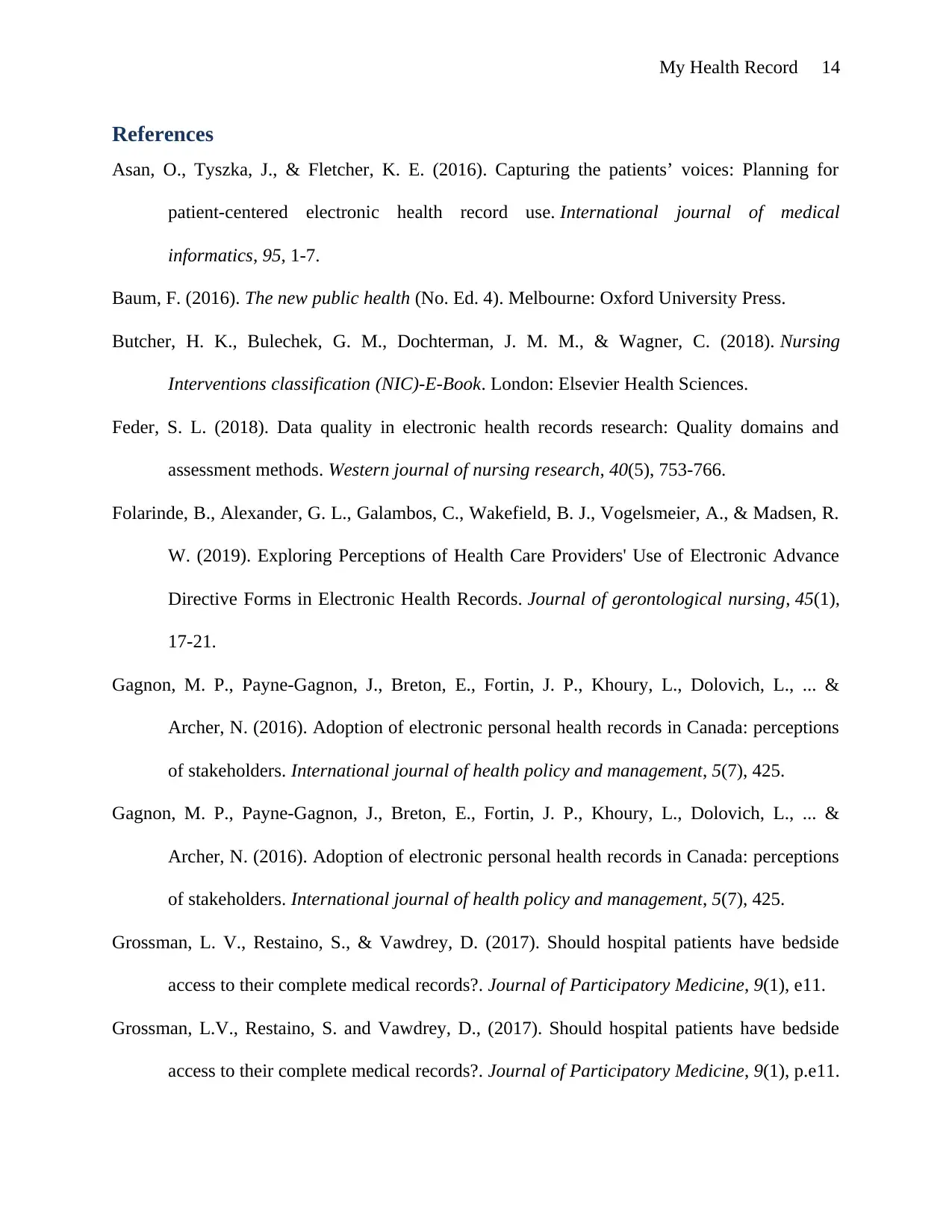
My Health Record 14
References
Asan, O., Tyszka, J., & Fletcher, K. E. (2016). Capturing the patients’ voices: Planning for
patient-centered electronic health record use. International journal of medical
informatics, 95, 1-7.
Baum, F. (2016). The new public health (No. Ed. 4). Melbourne: Oxford University Press.
Butcher, H. K., Bulechek, G. M., Dochterman, J. M. M., & Wagner, C. (2018). Nursing
Interventions classification (NIC)-E-Book. London: Elsevier Health Sciences.
Feder, S. L. (2018). Data quality in electronic health records research: Quality domains and
assessment methods. Western journal of nursing research, 40(5), 753-766.
Folarinde, B., Alexander, G. L., Galambos, C., Wakefield, B. J., Vogelsmeier, A., & Madsen, R.
W. (2019). Exploring Perceptions of Health Care Providers' Use of Electronic Advance
Directive Forms in Electronic Health Records. Journal of gerontological nursing, 45(1),
17-21.
Gagnon, M. P., Payne-Gagnon, J., Breton, E., Fortin, J. P., Khoury, L., Dolovich, L., ... &
Archer, N. (2016). Adoption of electronic personal health records in Canada: perceptions
of stakeholders. International journal of health policy and management, 5(7), 425.
Gagnon, M. P., Payne-Gagnon, J., Breton, E., Fortin, J. P., Khoury, L., Dolovich, L., ... &
Archer, N. (2016). Adoption of electronic personal health records in Canada: perceptions
of stakeholders. International journal of health policy and management, 5(7), 425.
Grossman, L. V., Restaino, S., & Vawdrey, D. (2017). Should hospital patients have bedside
access to their complete medical records?. Journal of Participatory Medicine, 9(1), e11.
Grossman, L.V., Restaino, S. and Vawdrey, D., (2017). Should hospital patients have bedside
access to their complete medical records?. Journal of Participatory Medicine, 9(1), p.e11.
References
Asan, O., Tyszka, J., & Fletcher, K. E. (2016). Capturing the patients’ voices: Planning for
patient-centered electronic health record use. International journal of medical
informatics, 95, 1-7.
Baum, F. (2016). The new public health (No. Ed. 4). Melbourne: Oxford University Press.
Butcher, H. K., Bulechek, G. M., Dochterman, J. M. M., & Wagner, C. (2018). Nursing
Interventions classification (NIC)-E-Book. London: Elsevier Health Sciences.
Feder, S. L. (2018). Data quality in electronic health records research: Quality domains and
assessment methods. Western journal of nursing research, 40(5), 753-766.
Folarinde, B., Alexander, G. L., Galambos, C., Wakefield, B. J., Vogelsmeier, A., & Madsen, R.
W. (2019). Exploring Perceptions of Health Care Providers' Use of Electronic Advance
Directive Forms in Electronic Health Records. Journal of gerontological nursing, 45(1),
17-21.
Gagnon, M. P., Payne-Gagnon, J., Breton, E., Fortin, J. P., Khoury, L., Dolovich, L., ... &
Archer, N. (2016). Adoption of electronic personal health records in Canada: perceptions
of stakeholders. International journal of health policy and management, 5(7), 425.
Gagnon, M. P., Payne-Gagnon, J., Breton, E., Fortin, J. P., Khoury, L., Dolovich, L., ... &
Archer, N. (2016). Adoption of electronic personal health records in Canada: perceptions
of stakeholders. International journal of health policy and management, 5(7), 425.
Grossman, L. V., Restaino, S., & Vawdrey, D. (2017). Should hospital patients have bedside
access to their complete medical records?. Journal of Participatory Medicine, 9(1), e11.
Grossman, L.V., Restaino, S. and Vawdrey, D., (2017). Should hospital patients have bedside
access to their complete medical records?. Journal of Participatory Medicine, 9(1), p.e11.
Secure Best Marks with AI Grader
Need help grading? Try our AI Grader for instant feedback on your assignments.
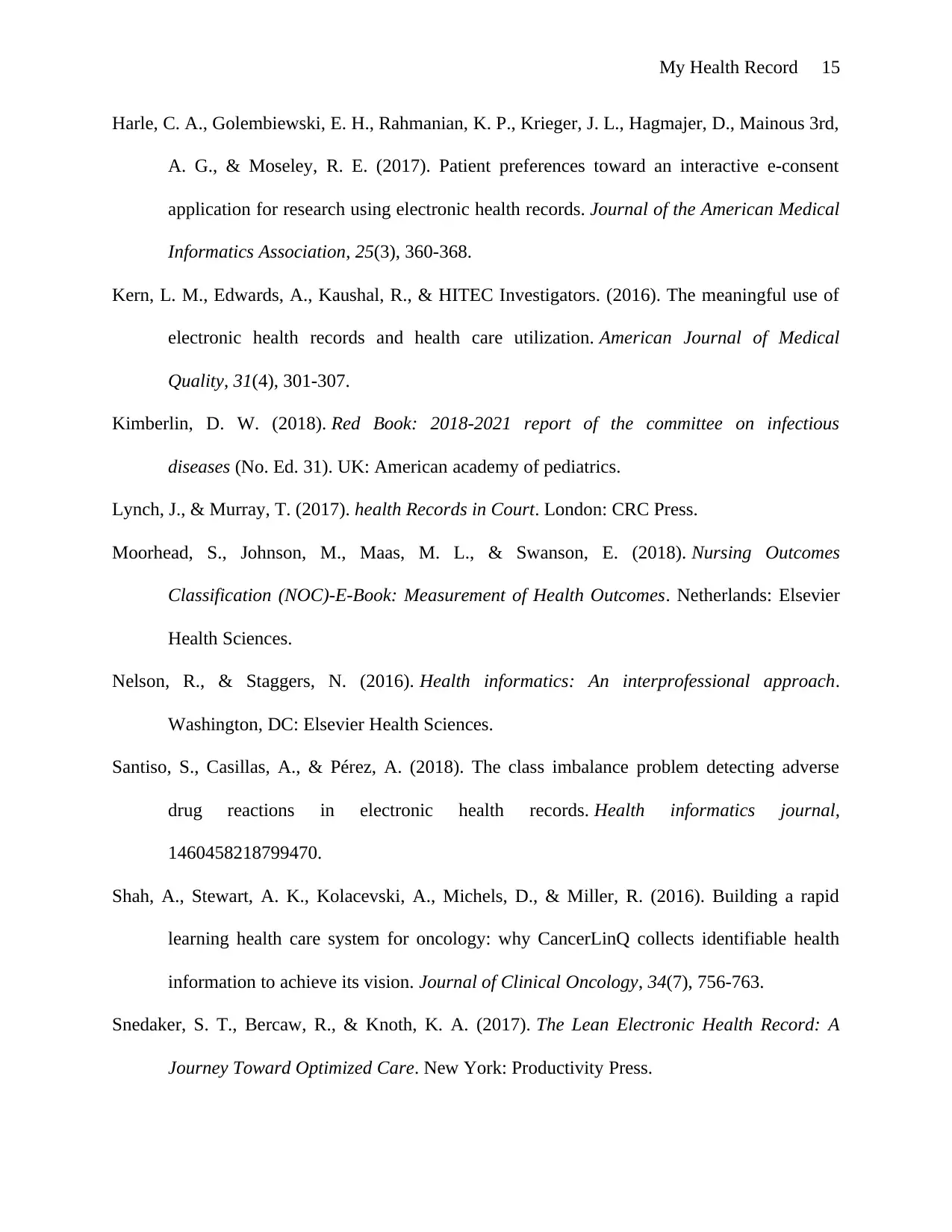
My Health Record 15
Harle, C. A., Golembiewski, E. H., Rahmanian, K. P., Krieger, J. L., Hagmajer, D., Mainous 3rd,
A. G., & Moseley, R. E. (2017). Patient preferences toward an interactive e-consent
application for research using electronic health records. Journal of the American Medical
Informatics Association, 25(3), 360-368.
Kern, L. M., Edwards, A., Kaushal, R., & HITEC Investigators. (2016). The meaningful use of
electronic health records and health care utilization. American Journal of Medical
Quality, 31(4), 301-307.
Kimberlin, D. W. (2018). Red Book: 2018-2021 report of the committee on infectious
diseases (No. Ed. 31). UK: American academy of pediatrics.
Lynch, J., & Murray, T. (2017). health Records in Court. London: CRC Press.
Moorhead, S., Johnson, M., Maas, M. L., & Swanson, E. (2018). Nursing Outcomes
Classification (NOC)-E-Book: Measurement of Health Outcomes. Netherlands: Elsevier
Health Sciences.
Nelson, R., & Staggers, N. (2016). Health informatics: An interprofessional approach.
Washington, DC: Elsevier Health Sciences.
Santiso, S., Casillas, A., & Pérez, A. (2018). The class imbalance problem detecting adverse
drug reactions in electronic health records. Health informatics journal,
1460458218799470.
Shah, A., Stewart, A. K., Kolacevski, A., Michels, D., & Miller, R. (2016). Building a rapid
learning health care system for oncology: why CancerLinQ collects identifiable health
information to achieve its vision. Journal of Clinical Oncology, 34(7), 756-763.
Snedaker, S. T., Bercaw, R., & Knoth, K. A. (2017). The Lean Electronic Health Record: A
Journey Toward Optimized Care. New York: Productivity Press.
Harle, C. A., Golembiewski, E. H., Rahmanian, K. P., Krieger, J. L., Hagmajer, D., Mainous 3rd,
A. G., & Moseley, R. E. (2017). Patient preferences toward an interactive e-consent
application for research using electronic health records. Journal of the American Medical
Informatics Association, 25(3), 360-368.
Kern, L. M., Edwards, A., Kaushal, R., & HITEC Investigators. (2016). The meaningful use of
electronic health records and health care utilization. American Journal of Medical
Quality, 31(4), 301-307.
Kimberlin, D. W. (2018). Red Book: 2018-2021 report of the committee on infectious
diseases (No. Ed. 31). UK: American academy of pediatrics.
Lynch, J., & Murray, T. (2017). health Records in Court. London: CRC Press.
Moorhead, S., Johnson, M., Maas, M. L., & Swanson, E. (2018). Nursing Outcomes
Classification (NOC)-E-Book: Measurement of Health Outcomes. Netherlands: Elsevier
Health Sciences.
Nelson, R., & Staggers, N. (2016). Health informatics: An interprofessional approach.
Washington, DC: Elsevier Health Sciences.
Santiso, S., Casillas, A., & Pérez, A. (2018). The class imbalance problem detecting adverse
drug reactions in electronic health records. Health informatics journal,
1460458218799470.
Shah, A., Stewart, A. K., Kolacevski, A., Michels, D., & Miller, R. (2016). Building a rapid
learning health care system for oncology: why CancerLinQ collects identifiable health
information to achieve its vision. Journal of Clinical Oncology, 34(7), 756-763.
Snedaker, S. T., Bercaw, R., & Knoth, K. A. (2017). The Lean Electronic Health Record: A
Journey Toward Optimized Care. New York: Productivity Press.
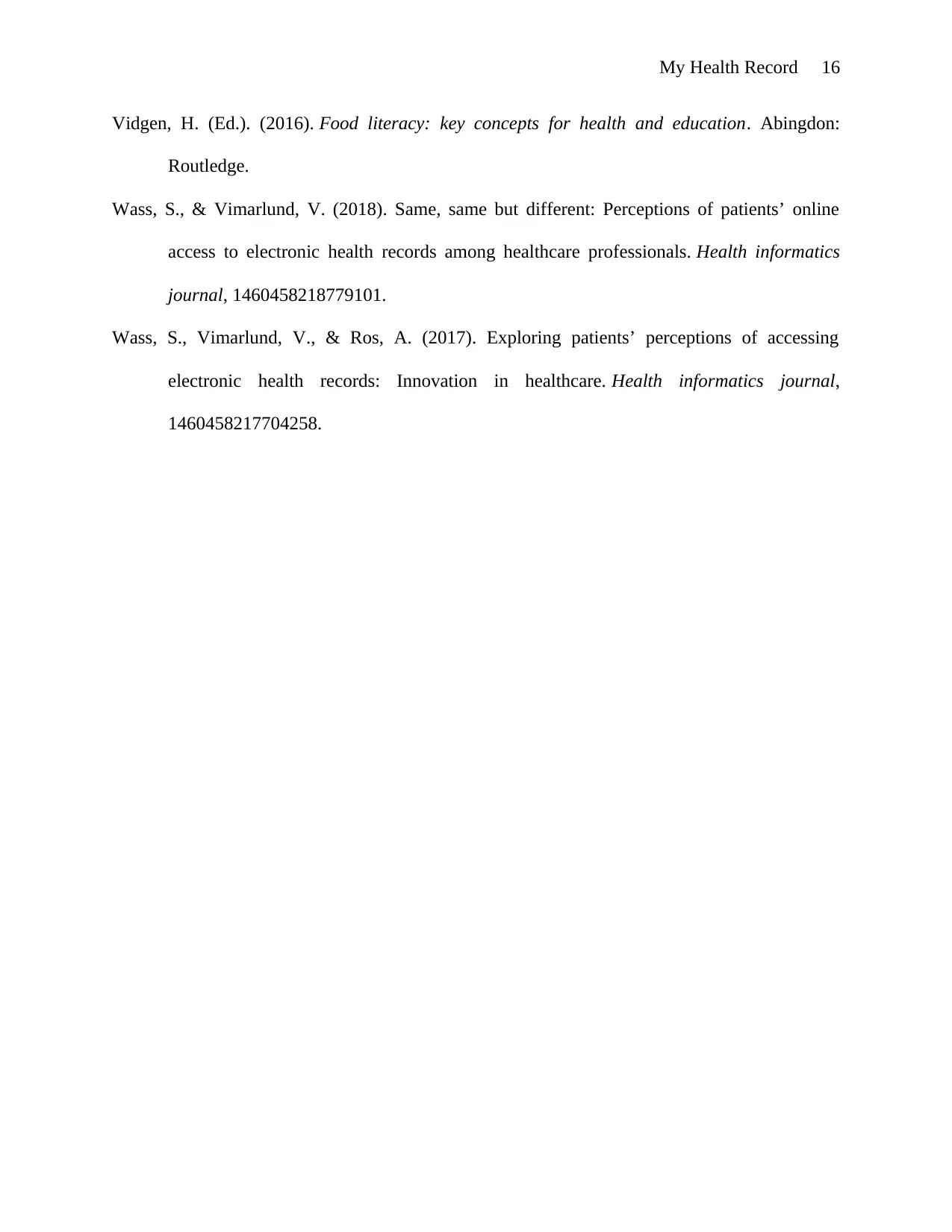
My Health Record 16
Vidgen, H. (Ed.). (2016). Food literacy: key concepts for health and education. Abingdon:
Routledge.
Wass, S., & Vimarlund, V. (2018). Same, same but different: Perceptions of patients’ online
access to electronic health records among healthcare professionals. Health informatics
journal, 1460458218779101.
Wass, S., Vimarlund, V., & Ros, A. (2017). Exploring patients’ perceptions of accessing
electronic health records: Innovation in healthcare. Health informatics journal,
1460458217704258.
Vidgen, H. (Ed.). (2016). Food literacy: key concepts for health and education. Abingdon:
Routledge.
Wass, S., & Vimarlund, V. (2018). Same, same but different: Perceptions of patients’ online
access to electronic health records among healthcare professionals. Health informatics
journal, 1460458218779101.
Wass, S., Vimarlund, V., & Ros, A. (2017). Exploring patients’ perceptions of accessing
electronic health records: Innovation in healthcare. Health informatics journal,
1460458217704258.
1 out of 18
Related Documents
Your All-in-One AI-Powered Toolkit for Academic Success.
+13062052269
info@desklib.com
Available 24*7 on WhatsApp / Email
![[object Object]](/_next/static/media/star-bottom.7253800d.svg)
Unlock your academic potential
© 2024 | Zucol Services PVT LTD | All rights reserved.





